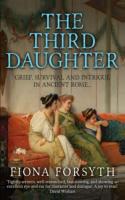
Sharpe Books (2022) p/b 262pp £7.99 (ISBN 9798414913399)
This book is based on the life of the real historical figure, Junia Tertia, the third daughter of Servilia (hence her father’s nickname for her, ‘Tertulla’, or ‘Little Third’). Servilia, also a real historical figure, was an aristocratic lady of the Late Roman Republic and the mother of Brutus, one of Caesar’s assassins. Not only was Tertulla the half-sister of Brutus, she was also married to Cassius, another of the assassins.
The basic premise running through the tale is that Tertulla thinks she might not be the child of Servilia’s husband, Junius Silanus, but rather the offspring of Servilia and her lover, Julius Caesar. This starting point is based on references in the ancient sources to the rumours of an affair between the two. Thus, as F. imagines Tertulla wondering whether Caesar is her real father, we are taken through the events of Roman history that deal with Caesar’s rise to power, the subsequent civil wars, his dictatorship and his assassination. Tertulla and her mother are shown as conflicted between Caesar and the old Roman nobility he seems bent on destroying.
In a Prologue, set in AD22, we learn from Tertulla who she is and what she believes her background is. This personal approach is an attractive feature of the book. One becomes a part of the story, watching as the characters she portrays come to life and we come to share their doubts and fears concerning the political events in their lives. The reader is then led at a good pace through the history of the Late Republic with the action of the narrative alternating between domestic life and the high politics of the time. This mix of factual history and imagined family life is well woven.
F. concentrates much of her account on the influence Servilia and her daughters try to exert on their closest menfolk, but along the way we also encounter other famous figures such as Pompey, Crassus, Cicero, Cleopatra, Antony and others too numerous to list. The discussions that must have taken place between these historical figures during this period of uncertainty for the Roman elite are nicely drawn and skilfully balanced. The reader, like the characters, can weigh up the arguments on both sides and draw their own conclusions as to where they would have stood, had they been there themselves.
But it is not just the well-known figures who are described with their thoughts and actions, the reader is also treated to descriptions of triumphs, violence in the City, weddings and funeral rites—this last is well written and observed. After we learn of the family’s reaction to the murder of Caesar and the subsequent dilemmas faced by Brutus and Cassius, we are taken on to the rise of Octavian and the further battles of the new civil war between him and Antony, culminating in the triumphal celebration of Octavian on his return from Actium. In the Epilogue, dated, as is the Prologue, 22 CE, we learn of the death of Tertulla and the story ends with a quotation from Tacitus III.76, briefly describing her funeral.
There are occasions in the book where the proofreading has not been quite as thorough as it might and ‘equestrians’ are mentioned without any clear explanation as to which stratum of society they were, but these are minor imperfections. F. has researched her material carefully and the result is a really enthralling read, both for the student of the Late Republic or the newcomer to the period, though trying to keep up with the relationships between all the protagonists and their various family ties can be a little bewildering at times.
Mike Smith
